
|   |

|   |
 e-mail: leelakaverivenkat@gmail.com Nrityaparva 2021 dedicated to lately departed stalwarts February 18, 2021  Travails of Covid 19 apart, this year of the pandemic has seen the dance community lose some of its most coveted contributors in different fields of art scholarship and practice. Substituting the customary performance glitz and dedicating Nrityaparva 2021to the much-mourned departed souls of Dr. Kapila Vatsyayan, Phillip Zarrilli, Astad Deboo and Dr. Sunil Kothari, was a fitting, sensitive gesture. Conceived, coordinated and executed by Anjali Memorial Committee, the three day virtual event was supported by the Alumni Affairs and Donors Relation of the Maharaja Sayajirao University of Baroda and the ICCR Gujarat. Following the curtain raiser with prayer and good wishes by Rajya Sabha member Dr.Sonal Mansingh, a fleeting overview of Anjali Mehr (in whose memory Anjali Memorial was set up) recaptured how as a Kalakshetran and favourite student of late Rukmini Devi, she had established herself, as a venerated artist in Vadodra. The opening day's requiem was predictably to that colossus of art and aesthetic scholarship, Dr Kapila Vatsyayan. An original thinker, well versed in Vastu Sastra, Shilpa Sastra and Sangit Sastra, Dr. Vatsyayan's prodigious intellect deciphered with rare clairvoyance the inter-connectivity and the give and take among the multi strands of Indian art - all flowing from the world view wherein all aspects of life inanimate and animate, are viewed as evolving from one reality - wherein no aspect of life exists in complete autonomy and isolation. The IGNCA which Dr. Vatsyayan headed for years, like the Smithsonian Institute in USA, reflected in its working this coming together of the sciences, humanities and arts - a fact which was well brought out in her brief introduction by Molly Kaushal, whose work on Janapada and tribal areas for years in IGNCA under Kapila Vatsyayan gave her a complete understanding that what was wrongly understood as separate traditions of classical, tribal and folk were but parts of one indivisible whole. One could not have existed without the others. 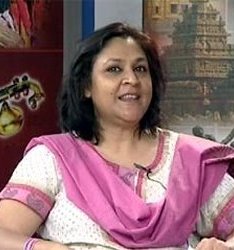 Molly Kaushal 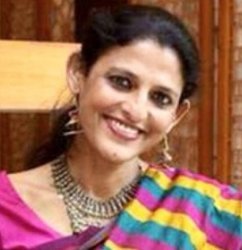 Navina Jafa Navina Jafa's intervention, very telling in its clarity, pointed out how her closeness to Kapilaji who she came to know when she was a bare ten and a half years old, had taught her how Culture was a response to geography and as a visionary, Kapilaji was convinced that Culture and Politics had to closely interact for the world to be more unified. Her Asia project for IIC was built on this premise. To catch the versatility of a personality like Kapila Vatsyayan combining scholarship with astonishing administrative and institution building abilities, was arguably the most demanding part of the festival. Compelled by unavoidable dependence on videos from different sources, along with the fading nature of some of the very old material in the possession of Anjali Memorial, made for an evening of uneven visual quality, which was not surprising. Kapilaji's unique mind thought like no other. For instance her designing of the exhibition 'KAAL' for IGNCA posed many questions. What is Time? How does one define going beyond Time and prescribed formats? What constitutes Art? Is it different from Contemplation or Meditation? Is Art emptying oneself of the 'I'? And yet can one experience art without the 'I'? Kapilaji was always posing these difficult questions to herself, trying to find answers. Notwithstanding Kapilaji's dance practice which began with 'Oriental Dance' followed by formal training in the classical styles of Kathak, Manipuri, Bharatanatyam, Odissi, not forgetting her deep understanding of Kathakali, and forms like the Bhagavata Mela Natakam, it was the touchstone provided by her Laban Studies in the West that made her analysis of body movement of Indian dance second to none. Old video snippets 'caught a peep of her demonstrating the body in relationship to the floor in a stance, and the tilts with change in body weight. Fleeting visuals of her great admirer Yamini Krishnamurti (whose Delhi appearance owed much to Kapilaji) and of Rama Vaidyanathan speaking of how following Kapilaji's advice to her, after watching her varnam on Brihadeeswara, had enriched her interpretation following a close look at the Brihadeeswara Rajarajeswaram temple in Tanjavur. 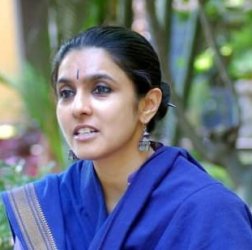 Parwati Dutta 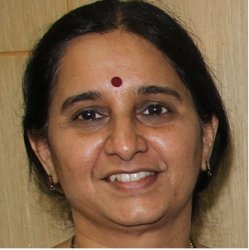 Anuradha Jonnalgadda Parwati Dutta spoke of her work in Mahagami Gurukul, wherein she had tried to incorporate Kapila Vatsyayan's advice into her research into Sarangadeva's Sangeet Ratnakara - to look beyond the interpreted text and to engage as a seeker in literature which coupled with contemplation had opened out a new vista of understanding, with a synergy of Parampara as mentioned in Sanskrit texts and are connection with Prayoga. She has started a special 'Vidya Arangam' on the outskirts of Aurangabad and Kapila Vatsyayan's writings have provided the guiding light. The video of Parwati's performing a thumri in Behag "Pratham milap kunja gali...." ,sensitive and underplayed in the abhinaya while good, seemed totally unconnected with the subject of the discussion. Anuradha Jonnalgadda from Hyderabad spoke of how Kapilaji's talks and writings as source material, coupled with her guidance and that of scholar Nataraja Ramakrishna, had helped her understanding of dance. For her profession involving dance pedagogy, she had been greatly educated by reading Kapila Vatsyayan's books, containing systematised material, expressed in a suitable language explaining dance, keeping in the Indian context. The concluding segment with Sharanya Chandran's Bharatanatyam rendition of her own choreography of a Mallari composition by late Shivkumar in raga Hamsadhwani, in the projection saw the dancer at times seeming to skim over the surface - thereby blurring intricacies of rhythm and line. The next part, more homogenously planned, comprised a tribute to the American born director, writer, actor and professor of performance practice (called the mindful thespian) Phillip Zarrilli (1947-2020) who worked for Wisconsin University in Madison - training actors and equipping them with the conceptual tools with which to approach theatre. Tai Chi trained, he was deeply drawn to Kalaripayattu for which he trained, along with Kathakali and Yoga - all as active preparatory methods for breath training and for imbibing structure and focus needed by the actor by "cleaning pathways of interiority and exteriority." Kavalam Narayana Panikar and another Sanskrit scholar were his advisers aiding the understanding of the Sanskrit text on which his works with English dialogue, were often based. His own book on Psychophysical Acting won the 'Book of the year' award. Very interesting in body movement, clearly reflecting the influence from Keralite traditions, were excerpts of video material from some of his work for the 1985 India festival - Urubhangam and also Bhagavat Ajjukai, with Prof. Parul Shah as choreographer for the latter. In keeping with Sanskrit theatre tradition, the latter play in English sported the character of the Vidhushaka. Zarrilli's production Walking Naked produced working with Geetanjali Kolanad, was based on 12th century fiery poetess Akka Mahadevi's poetry and was uniquely conceived, with three puppets. Geetanjali Kolanad remembering her invaluable association with Phillip Zarrilli while she was working for Shiv Nadar University in Toronto, mentioned his unique ideas on body/mind coordination, to which he added an ability for visualising Indian aesthetic in a very contemporary way. Dr. Parul Shah mentioned how Zarrilli used Kalaripayattu training for understanding and opening out the senses. 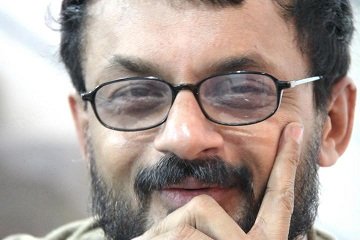 K.K. Gopalakrishnan Scholar and Writer K.K. Gopalakrishnan who shared a close friendship with Phillip spoke of how Phillip used Kerala traditions for making the Body "all eyes". He also very frankly criticised some of the views expressed in Phillip's book on Kerala's moral practices regarding extra marital relationships, which he said, as an accepted societal mode at that time, was not promiscuity as Zarrilli understood. He also pointed out certain inaccuracies on details in the book - which he attributed to the usual problem of foreign scholars having to depend for source information on less informed sources. The performance part with Kathakali rendered by the fine teacher and performer Aasan Balasubramaniam, Principal of Kalamandalam, followed by an involved rendition of Mohiniattam by Neena Prasad (trained under Sugandhi and Kshemavathy) of the Swati Tirunal composition Panimadi mukhi bale expressing the nayika's separation pangs, made for a fitting end to the evening. Truly touching while capturing a feel of the person no longer with us, was the second evening dedicated to Astad Deboo, who had a long and close association with Baroda. What stood out was the warmth and admiration for the artistic and human qualities of this man along with a deep sense of regret at losing him. It began on a personal note with Astad himself speaking on how media had been rarely supportive of him in early years. Touching on his collaborating with the Dhol Cholom artists of Manipur, he spoke on how his work was based on 'listening to the body' and in collaborative efforts acting as a catalyst for the others involved in the work. In 'Friend and Me' just working with two hands, he had tried to create an exchange. In 'Thanatomorphia' portraying many facets of death, his collaboration involved working with Dadi Padumjee's puppets. Working with 15 artists cutting across Classical /Contemporary boundaries, the connection issue was solved by artists talking of themselves and their creative processes. He strove for a minimalistic body language, and his constant exercising of the body had resulted in a strong back which could take all the strain. Bharatanatyam dancer Hema Rajagopalan in Chicago having met Astad in 1984 during 'Mera Bharat Mahaan' started collaborating with him only in 2015. Vilambit singing of the Kshetrayya lyric 'Paiyyada' with both Hema and Astad absorbed in savoured abhinaya (problematic since one needs to lose oneself in bhava while keeping stage positions in mind with two people sharing space) created an unusual duet of Bharatanatyam and Contemporary expression. The experiment in pure nritta comprising a longish teermanam too seemed well matched with two very different body languages interacting in a duet. It is a telling factor that no classical solo dancer within India ever collaborated with Astad. 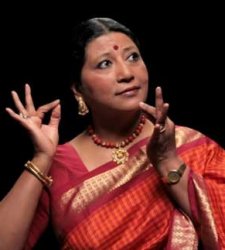 Hema Rajagopalan 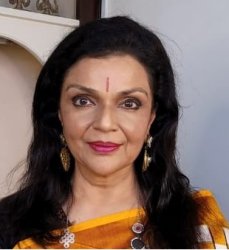 Anita Ratnam After this came Anita Ratnam's poetic eloquence on how Astad, transcending all boundaries of tradition and modern seemed to embody stillness - suspending elastic time - performing with equal ease whether in skin-tight leotards or in a long angarkha or performing with yards of fabric swirling below and above waist. Not a frequent figure in tightly traditional dance circles, it was serendipitous when Astad performed at Kalakshetra - one 'rebel' performing in the abode of another 'rebel' Rukmini Devi. It was like footprints on the sands of Time, as he danced to delightful raga music - Charukeshi, Revati et al. Arshiya Sethi's spirited intervention dilated on her interactions with Astad, whose introduction to her was through Natya Ballet Centre. His works like 'Lakdi Ka Ravan seemed to connect with her studies at the Lincoln Centre in New York on Politics and Society reflecting activism in Art. She touched on his sarvaangabhinaya using the entire body (not forgetting his haircuts in myriad designs), communicating emotion and evoking rasa. With Zee TV award and general funding, he started explorations with Thang-Ta, with 10 Manipuri dancers and Jazz dancers. His Rhythm Divine presented in the Frankfort Book Fair, had each rasa in a different rhythm conveying moods. His counter positioning of sublime quietude with Jhakta movements showed how the body for him was to convey and communicate through movement unbound by classifications. She spoke warmly of his concern for people and at the same time she found a spark of the political in him - in his never missing being part of the Safdar Hashmi festival! 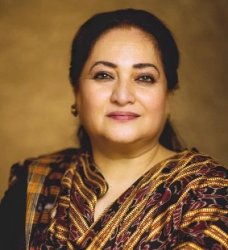 Arshiya Sethi 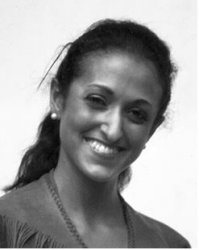 Uttara Asha Coorlawala Like Astad in her mixed training under Kadirvelu, Thankamani Pillai and Cunningham School in 1992 (involving Indian Classical Dance and Contemporary Dance in the West), Uttara Asha Coorlawala was first exposed to Astad auditioning in 1974 in New York, where "he danced his way into my heart" she said. In 1992, she and Astad collaborated. And for her famous 'Saree' dance of which an excerpt was shown (full of grace in the way she draped and handled yards of material), it was Astad who had draped her saree, with yards left loose for handling during the dance. Constantly on the move, Astad she said had admitted to not having spent a full year in any country. Change of environment, food, people seemed to charge him with new ideas and he absorbed influences like a blotting paper. The video of art activist Mallika Sarabhai's very short work, screamed out a strong message. Does one gnash one's teeth or dance when man's insensitivity has created a sky which has lost its blue and the Earth its green? The last evening's tribute to Dr. Sunil Kothari, found voluble participants, not surprising given Dr. Kothari's love for bonding with people of all ages and groups. And with his close connections with Baroda (he was the first PHD of the Baroda University) the Lifetime Achievement Award by the Anjali Memorial Committee in 2018, seemed special to him - for such a recognition from one's home as it were, signified a real acknowledgement of goals achieved. The starting point of a long journey was Sunil Kothari's insistence that Anjali Mehr conduct research and write (in Gujarati) on Chandramauleeshwar Kuravanji, (substantiated by a very short clip of the Kalakshetra version of Kuravanji showing the Kuratti or gypsy), a tradition that he worked on for his PHD scholarship. Mohan Khokar and Mulk Raj Anand were Sunil's mentors and to his great good fortune he met and interacted with the best of Gurus and artists. Sunil narrated his first meeting with Mrinalini Sarabhai (an episode he has dilated on in several articles) and his introduction to the Bhagavata Mela Natakam of which a well known excerpt showed Kumar's enactment of the role of Hiranyakashipu. Kalakshetra Director Revathi Ramachandran in her tribute spoke of Dr. Kothari as an outstanding connoisseur of all art and one who was known for giving positives to the dancer in his critiquing. She referred to how highly Kalakshetra and ex-President R.Venkataraman, who was Chairman of the institution at the time, valued and commended Sunil's photographic biography of Rukmini Devi. Being with Rukmini Devi and getting to know the Theosophical Society was art education in itself for Sunil Kothari. Kothari's friends in the art world were many, pertaining to different disciplines. He treasured his sixty year friendship with painter and art critic of the Gujarat Faculty of Performing Arts, Ghulam Sheikh. Very close to him were Bhupen Kakkar, the painter Vivan Sundaram, many poets, Kapila Vatsyayan and dancers like Yamini Krishnamurti, photographers like Avinash Pasricha and above all his very close friend, late dancer Chandralekha. 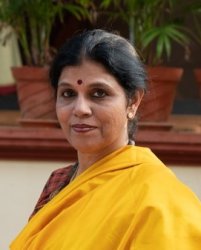 Revathi Ramachandran 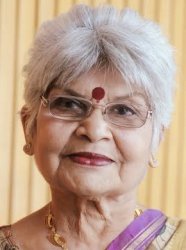 Manjari Sinha Music/dance critic Manjari Sinha enthused about how she first met Sunil Kothari at Khajuraho during the dance festival and was bowled over by his frenetic energy in meeting people, getting to know them, interacting with artists, being in time for the early morning photo sessions at the temple site for a tete a tete with the dancers and looking round the temples (for the nth time) and being ever ready for the Lokranjan comprising traditions like Macha from different States projected immediately after the classical dance recitals. Always at pains to keep in one group, the three critics (Sunil, Manjari and myself) 'Trimurti' as he called us, his photographs of the three seated together decorated many a facebook page. Sunil Kothari, ever encouraging of art work which went beyond prescribed boundaries, laying out new paths, was a very close friend and supporter of song writer and Fusion pioneer Asha Putli, a graduate of Maharaja Sayajirao University of Baroda .When this singer had exhausted looking for scholarship avenues in India, Sunil Kothari who was responsible for urging her to learn some Odissi, Bharatanatyam and Kathak from Sunderlalji, suggested that she try for something in the States and she succeeded, never looking back - singing rock, pop, blues, funk and what have you. With Sunil, she visited Vallathol, the Mattancheri temple and even met the Mantravaadi getting the proper flavour of Kerala. Her album "The devil is loose" became an instant success. And excerpts of her fusion work with delightful singing, combining the art sensibilities of East and the West, showed her performing to jam packed audiences, the crooner belonging to the world. Ananda Shankar Jayant, Director of Shankarananda Kalakshetra in Hyderabad, spoke of the encouragement she got from Sunil Kothari, a compulsory presence in all her festivals. He also made suggestions after watching productions like 'What about Me?' "Let us celebrate the life" of one, who crashed walls between critic and artist. Sunil Kothari's connections with Manipuri (years spent in the company of Guru Bipin Singh and constant visits to Manipur), and with Sattriya (the first researcher to pioneer Bora information by visiting Sattras of Assam) are known. So the performance part of the festival had Sattriya by Anwesa Mahanta, student of Guru Ghanakanta Bora, and by far one of the best dancers of today, followed by Lilawati who did an ethnographic study of the Sangai Haraoba presenting Gita Govind in Manipuri. There was also Kathak by Rohit Par. On all the days, Dr. Prof Parul Shah held the programme together with her brief interventions. 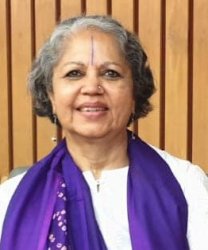 Parul Shah 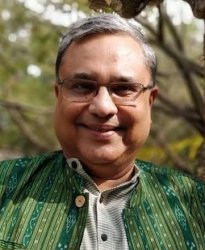 Rajiv Chandran Art activist Rajiv Chandran speaking warmly of Sunil Kothari's ability for getting close to people, cutting across generations and categories, called him a pure rasika, his passion for dance and for people unsurpassed. His recollections of what he had seen generations ago, along with his painstaking notes on all his contacts, constitute a lifetime of rich material - very significant while looking back at dance history. A frugal eater, his passion for the arts was phenomenal - if not dance, he would see a film during the evening and was a great film buff. He destroyed all pillars separating artist and critic. Geeta Chandran next presented a short abhinaya number based on Tagore's Bhuvananeshwara, the song rendered by O.S. Arun. What better way to end this three day saga of eulogy than Rajiv Chandran's quotation from If by Rudyard Kipling, in his tribute to Sunil Kothari. "If you can't talk with crowds and keep your virtue, Or walk with Kings - nor lose the common touch, If neither foes nor loving friends can hurt you. If all men count with you, but none too much: If you can fill the unforgiving minute - With sixty seconds worth of distance run, Yours is the Earth and everything in it."  Writing on the dance scene for the last forty years, Leela Venkataraman's incisive comments on performances of all dance forms, participation in dance discussions both in India and abroad, and as a regular contributor to Hindu Friday Review, journals like Sruti and Nartanam, makes her voice respected for its balanced critiquing. She is the author of several books like Indian Classical dance: Tradition in Transition, Classical Dance in India and Indian Classical dance: The Renaissance and Beyond. Post your comments Pl provide your name and email id along with your comment. All appropriate comments posted with name and email id in the blog will also be featured in the site. |